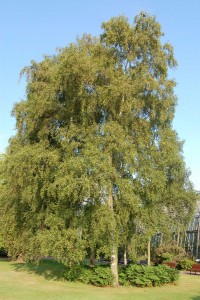Birch – Betula pendula (Betulaceae)
Gaelic: beith
Common Names: Silver Birch
The birch is native throughout Europe, and can be found more widely as it is an attractive tree frequently used in gardens and parks. The drooping form of birch is reflected in the Latin name ‘pendula’. The white peeling bark is also very distinctive and this has given rise to its common name the ‘silver birch’. Flowers are catkins which appear in early Spring, with male and female flowers occurring separately on the same tree (monoecious) and are wind pollinated. The birch is a pioneer species, meaning it is one of the first trees to colonise new sites, changing the nature of earth and providing shelter enabling other species to colonise the area. After the last Ice Age it was one of the first tree species to re-colonise the landscape.
Birch has numerous uses, although the wood isn’t durable, it is extensively used to make household utensils. The bark is waterproof and has been used to make baskets, with evidence of this from 5,000 years ago, bark was also used in the tanning of animal hides. The smaller branches have traditionally been bound together to make brooms, and are said to be required along with an ash handle and willow binding to make a witches broom capable of flying. The sap of the birch can also be used for several purposes, including being boiled to make a waterproof glue or tar, fresh sap collected in the spring can be drunk and was believed to be beneficial for the bladder and kidneys. It can also be fermented to make a delicious birch wine.
Location


2 Comments
2 Pingbacks